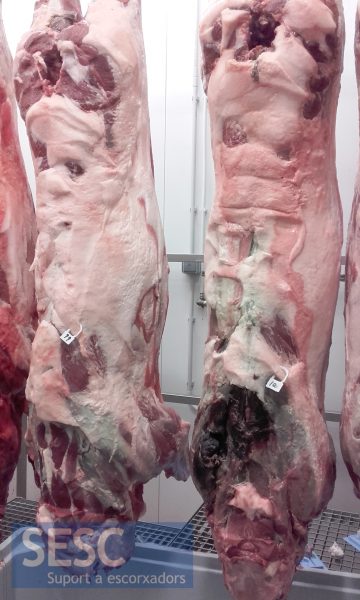Postmortem decomposition changes in wild boar carcasses
Samples and images from wild boar carcasses with greenish discoloration were submitted to SESC, from a game meat processing establishment.
According to the inspector this coloration appeared one day after slaughter/dressing, initially affecting the cranial region of the carcass, subcutis and superficial muscle layers. Over time, it extended caudally and delved into the muscle tissue. Often the alteration was observed also in adjacent carcasses. She also described that this change was accompanied by a foul odor. This alteration is estimated to be approximately observed in up to 2% of the carcasses of this species.
These consist in postmortem decomposition changes due to autolysis and the proliferation of putrefaction bacteria. The microbiological culture of the samples showed growth of anaerobic bacteria compatible with Clostridium spp. and various strains of E. coli.
The source of bacterial contamination is probably related to the method of slaughter: the entrance of the projectile through the skin can drag outside contamination and lack of immediate cooling of the carcass may promote growth of bacteria. The location in the cranial area coincides with the area where the hunters are aiming at when shooting, as the shots aimed at the abdominal region are known to favor major carcass contamination by bacteria from the digestive tract. The fact that it appears in adjacent carcasses is suggestive of cross contamination between carcasses during preparation or by contact between them.



4 comment(s)
El significat estricte del terme autòlisi és: desintegració de cèl·lules o teixits per l’acció d’enzims endògens. Aquests processos, en els cadàvers, es veuen accelerats per la proliferació de bacteris ja siguin d’origen endògen, del tracte gastrointestinal, o contaminants des de l’exterior. El terme correcte per referir-se al conjunt de fenòmens (autòlisi + proliferació de bacteris) seria descomposició postmortem tot i que, en patología veterinària, se sol parlar d’autòlisi com a concepte general que engloba la proliferació bacteriana.
El significado estricto del término autolisis es: desintegración de células o tejidos por la acción de enzimas endógenos. Estos procesos, en los cadáveres, se ven acelerados por la proliferación de bacterias ya sean de origen endógeno, del tracto gastrointestinal, o contaminantes desde el exterior. El término correcto para referirse al conjunto de fenómenos (Autolisis + proliferación de bacterias) sería descomposición postmortem aunque, en patología veterinaria, se suele hablar de autolisis como concepto general que engloba la proliferación bacteriana.
There are some incorrections in the terminology. “Autolysis” should be substituted by “decomposition ” or “putrefaction”, or even “decay”. Autolysis is caused by lysosomal enzymes, which permeate an altered lysosomal membrane and subsequently digest the cell macromolecules. Autolysis has nothing to do with putrefactive bacteria.
Thanks for your comment José, indeed the term autolysis senso stricto refers to the disintegration of cells or tissues by endogenous enzymes. These changes are amplified and accelerated by bacterial proliferation in carcasses. The correct term to these changes would be “postmortem decomposition” or “putrefaction” albeit they are generally refferred to as autolysis by veterinary pathologists. We shall correct it in our post, thanks for reading us and for your input.
Compartim aquest comentari d’un/a inspector/a que hem rebut sobre el cas:
Volia comentar que des del moment que la peça és abatuda fins que s’eviscera poden passar hores. En el cas que estiguin més craneals jo crec que és pel fet que la zona de coll i espatlles en el porc senglar és molt musculada i el fred triga a entrar, a més que sol ser una zona que quan s’arrossega la peça per carregar és la que contacta amb el terra. Aquesta autolisi també es pot observar en ocasions a nivell de l’aixella atès que aquest punt és un dels que més triga en arribar el fred.
Però m’ha semblat molt bé el cas.